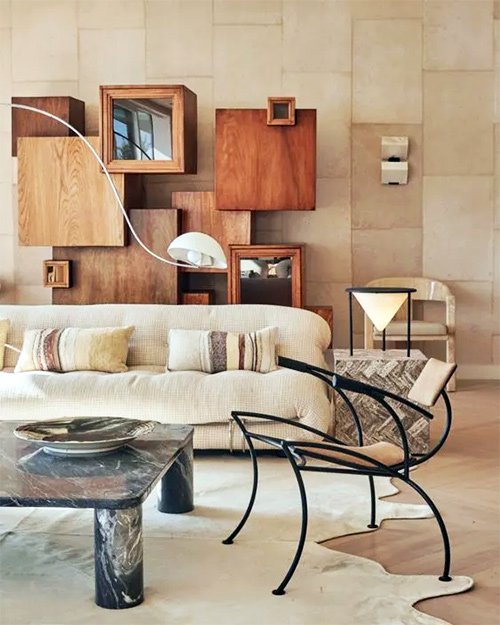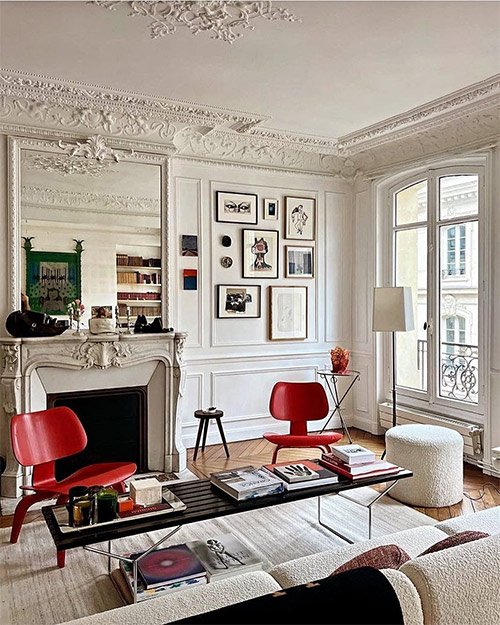In the world of interior design, vintage-inspired living rooms have become increasingly popular, offering a unique blend of nostalgia and contemporary style. This approach to design allows homeowners to incorporate beloved retro elements into their modern spaces, creating rooms that are both timeless and personal. In this article, we’ll explore how to successfully blend vintage charm with modern aesthetics to create a living room that’s both stylish and inviting.

@medium
Understanding Vintage Styles
To create a cohesive vintage-inspired living room, it’s important to understand the characteristics of different vintage eras. Some popular periods include:
- Mid-century modern (1940s-1960s): Known for clean lines, organic forms, and a focus on functionality.
- Art Deco (1920s-1930s): Characterized by bold geometric patterns, luxurious materials, and a sense of opulence.
- Victorian (1837-1901): Recognized for its ornate details, rich textures, and dark, dramatic colors.
- Retro (1950s-1970s): Defined by bold colors, quirky patterns, and space-age influences.
While you don’t need to strictly adhere to one era, choosing a primary style can help create a more cohesive look.

@decorilla
Color Palettes for Vintage-Inspired Living Rooms
Color plays a crucial role in setting the tone for your vintage-inspired space. Each era has its characteristic palette:
- Mid-century: Earth tones like olive green and mustard yellow, combined with bold primaries.
- Art Deco: Luxurious jewel tones such as emerald green, sapphire blue, and deep purples.
- Victorian: Rich, deep colors like burgundy, forest green, and royal blue.
- Retro: Pastels (think mint green and baby pink) alongside vibrant hues like orange and turquoise.
To avoid an overly themed look, consider using vintage colors as accents against a neutral backdrop. This approach allows you to incorporate vintage hues while maintaining a fresh, modern feel.

@decorilla
Furniture Selection and Placement
Furniture is perhaps the most impactful way to introduce vintage elements into your living room. Key vintage pieces might include:
- Iconic chairs: Eames lounge chair for mid-century, wingback chair for Victorian.
- Vintage sofas: Look for distinctive shapes like the kidney-shaped sofa or the high-backed Chesterfield.
- Retro coffee tables: Hairpin legs for mid-century, glass and brass for Art Deco.
When selecting furniture, aim for a mix of vintage and modern pieces to create balance. You might pair a vintage sofa with modern side tables, or place a contemporary sectional alongside a retro coffee table.
For authentic vintage pieces, explore thrift stores, estate sales, and online marketplaces. If you prefer new furniture, many manufacturers offer reproductions of classic designs. When arranging your furniture, create conversation areas that feel intimate yet open, a characteristic of many vintage living room layouts.

@decorilla
Textiles and Patterns
Textiles offer an excellent opportunity to introduce vintage patterns and textures. Consider:
- Geometric prints for mid-century and Art Deco inspired rooms
- Floral patterns for Victorian-inspired spaces
- Bold, quirky prints for a retro feel
Incorporate these patterns through:
- Curtains and drapes
- Throw pillows and blankets
- Area rugs
To prevent the room from feeling overwhelmed, balance vintage patterns with solid, modern textiles. For example, pair a boldly patterned vintage armchair with a solid-colored contemporary sofa.

@decorilla
Lighting in Vintage-Inspired Living Rooms
Lighting can significantly influence the ambiance of your vintage-inspired living room. Consider incorporating:
- Sputnik chandeliers for a mid-century space
- Tiffany lamps for Victorian or Art Nouveau inspiration
- Industrial-style fixtures for an early 20th-century feel
Layer your lighting with a mix of ambient, task, and accent lights to create a warm, inviting atmosphere. Many modern lighting manufacturers offer vintage-inspired designs that combine old-world charm with contemporary functionality.

@ad_italia
Accessories and Decor
Accessories and decor items are where you can really have fun with vintage elements. Consider:
- Wall art: Retro advertisements, vintage maps, or antique mirrors
- Decorative objects: Vinyl records and players, vintage clocks, or retro appliances as decor pieces
- Books and magazines: Display vintage books or retro magazines on coffee tables or bookshelves
- Plants and planters: Use mid-century inspired planters or Victorian-style terrariums
Remember to balance vintage accessories with modern pieces to maintain a fresh, current look.

@decormatters
Creating Focal Points
Every well-designed room needs a focal point. In a vintage-inspired living room, this could be:
- A statement furniture piece, like an ornate Victorian fireplace or a sleek mid-century sideboard
- An accent wall featuring vintage wallpaper or a bold paint color
- A gallery wall mixing vintage and modern art pieces
Your focal point should draw the eye and set the tone for the rest of the room’s decor.

@edwardgeorgelondon
Incorporating Modern Technology
One challenge in vintage-inspired rooms is integrating modern technology. Some strategies include:
- Hiding modern electronics in vintage-style cabinets
- Opting for vintage-inspired tech, like retro-style smart speakers
- Using cable management solutions to minimize visible wires
The key is to maintain the vintage aesthetic while accommodating modern conveniences.

@edwardgeorgelondon
Tips for Avoiding a Dated Look
To ensure your vintage-inspired living room feels fresh rather than dated:
- Maintain a clean, uncluttered space. Vintage doesn’t mean cluttered.
- Choose timeless vintage pieces rather than short-lived trends.
- Incorporate contemporary elements to balance the vintage pieces.
- Update vintage furniture with modern upholstery or paint.
- Balance vintage elements with modern finishes like sleek metal or glass.
DIY Projects for Vintage Flair
Adding DIY elements can personalize your space and enhance its vintage charm. Consider:
- Upcycling modern furniture with vintage techniques like distressing or decoupage
- Creating vintage-inspired art, such as framed retro fabric or old family photos
- Sewing projects for vintage-style pillows or curtains
- Restoring genuine vintage pieces to their former glory
DIY projects allow you to tailor your vintage elements to your specific taste and style.
Conclusion
Creating a vintage-inspired living room is about more than just decorating with old things. It’s about curating a space that tells a story, blending the charm of the past with the comfort and convenience of the present. By thoughtfully selecting colors, furniture, textiles, and accessories, you can create a living room that’s both a nod to the past and a reflection of your personal style.
